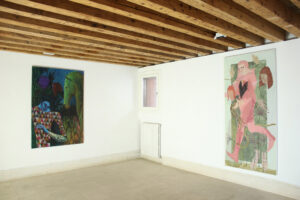The philosopher Walter Benjamin throughout his life pursued the idea of writing a work made exclusively of quotations, Passagenwerk. He argued that a quotation was not necessarily a throwback, but rather a way to recontextualize historical objects and ancient formulas in the contemporary world.
Similarly, the works exhibited in op.cit, a group exhibition open until January 31 2021 in the Venetian gallery A plus A, are full of references and images, which, alienated from the original context, find themselves in dialogue even though they belong to different generations, hence creating constellations of new possible meanings. The quote is in fact, the leitmotiv that connects the artists Paola Angelini, Luca De Angelis, Agnese Guido and Ella Walker. All four choose pictorial figuration as a means of recounting surreal atmospheres and ancient myths, although their artistic practices are located in universes of their own.
Paola Angelini‘s artistic production is full of references: from the history of art, to her biography, to her inner archive. Already in Danza Macabra a testa in giù it is possible to see the classic medieval topos of the cathartic dance against death, while the sculptures in the foreground recall those of the artist Pericle Fazzini. Angelini also uses an ancient painting technique, which involves the use of rabbit glue to stratify the surface of the canvas. The latter, which sometimes appears cracked, reveals the signs of a slow painting, which leaves time to the brushstrokes as well as to thoughts to settle down. Those of Angelini are in fact broken, interrupted, unfinished stories. The artist herself claims to often finish a painting only after having started another one. The end of the world represented by Angelini seems to be linked to that evoked by Benjamin in his Theses on the Philosophy of History, where with the phrase “une citation à l’ordre du jour” he affirmed how the past can be fixed only in the image which appears once and for all in the instant of his alienation, that is, on the day of the Last Judgment. This particular way of relating to the past constitutes another possible approach to understand this exhibition.
Luca De Angelis‘s paintings also cite key genres in the history of art, such as portraits and landscapes, mixing them together. A dense, lumpy, layered painting, often made of complementary colours, investigates the relationship between man and nature. The lunar figures of De Angelis are camouflaged in an almost alien vegetation, in which an underwater landscape seems to turn into a jungle.
I think of surrealism when I look at the humanized objects in Agnese Guido‘s paintings, which although they bring to mind the dimension of dreams, they do not tell of chimeras, but of the dark and paradoxical side of the everyday life. Her paintings disclose the attachment we have with things, our vices and our most uncontrolled instincts, but with an ironic and light taste.
In the works of Ella Walker, the reference to medieval iconography is evident. This is visible not only in the characteristic format of some canvases, reminiscent of medieval banners, but also in the flat and two-dimensional painting technique. Even the figures often seem to recall characters from the history of art, such as the myth, often subject of pictorial representations, of Judith with the head of Holofernes in He seems made of stone or the angel of the Cacciata dal Paradiso Terrestre by Masaccio in Exalt. In Walker’s paintings, often emerge fragments of figures whose bodies appear to have been erased. A hand, some feet, a head appear on the pictorial surface, ghostly and suspended. Their purpose is vague, but it resembles props from mysterious stories.
The exhibition itinerary is relevant as well, as in its circularity allows you to see the beginning once you reach the end. This idea of circularity appears intrinsic to the very concept of quotation. In fact, by using a quotation, one has the power to open a loop of references that does not necessarily respect a linear order. Rather, these references emerge from an instantaneous and punctual temporal dimension that is based on the redeeming power of memory. Only in this way, the viewer is free to grasp the potential relationships within the exhibition path.
Marina Silvello
Info:
 Op. Cit. Installation view A plus A Gallery, Venice. On the left: Luca De Angelis Untitled, 2020, oil on linen, 170 x 130 cm; right: Ella Walker He seems made of stone, 2020, acrylic on canvas, 100 x 210 cm
Op. Cit. Installation view A plus A Gallery, Venice. On the left: Luca De Angelis Untitled, 2020, oil on linen, 170 x 130 cm; right: Ella Walker He seems made of stone, 2020, acrylic on canvas, 100 x 210 cm
 Agnese Guido, The raw leaf and the chewing gum, 2019, gouache on paper, 31x 24 cm
Agnese Guido, The raw leaf and the chewing gum, 2019, gouache on paper, 31x 24 cm
 Paola Angelini, Danza Macabra a testa in giù, 2020, mixed media on canvas, 160 x 200 cm
Paola Angelini, Danza Macabra a testa in giù, 2020, mixed media on canvas, 160 x 200 cm

is a contemporary art magazine since 1980






NO COMMENT